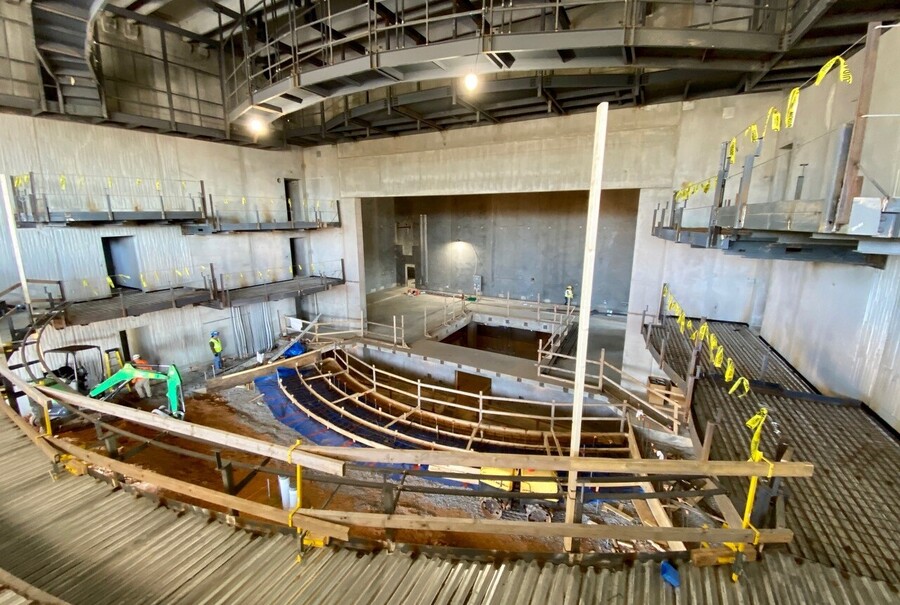This story is part of a package on the one-year anniversary of the COVID-19 lockdown.
The outbreak of the coronavirus pandemic stalled construction projects across the world. From supply chain hold-ups to worker safety to vanishing budgets, many jobsites were left empty and only work on essential construction projects—infrastructure, hospitals, and housing—kept going apace.
Still, many theatres are hard at work behind their closed doors. Steppenwolf Theatre Company in Chicago has crossed the two-year construction mark on its new 50,000-square-foot building; Red Mountain Theatre Company in Birmingham, Ala., has set the grand opening for a new Arts Campus for June 2021; and the Gulfshore Playhouse in Naples, Fla., is barreling toward their funding goal, having raised over $33 million for a new state-of-the-art cultural campus.
Indeed, many theatres across the country are using the mandated closure of their stages as a chance to renovate existing spaces, continue long-term expansions, update facilities with safety measures, or launch new projects in preparation for the eventual return of in-person performances.
While it may seem short-sighted to undertake large construction projects while artists and staff members struggle to find work, theatres have experienced an overwhelming show of support from patrons and communities for this work. Ideally, these extensive capital campaigns, which include funding that predates the on-set of the virus, represent an investment in performance venues and local economies that will long outlast the ravages of the pandemic.
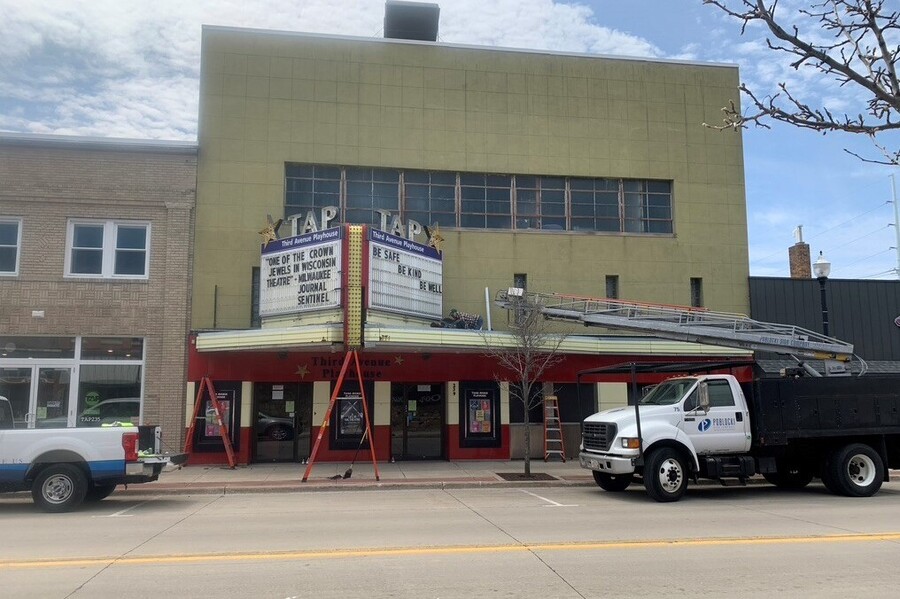
Third Avenue Playhouse
Third Avenue Playhouse (TAP) began a $2.6 million construction capital campaign in 2019 to renovate its 1950s cinema into a fully designed and functioning theatre, replacing what co-artistic director James Valcq referred to as “a series of band-aid repairs” and temporary solutions. When the COVID-19 pandemic shuttered theatres around the world in March of last year, TAP’s campaign pressed pause alongside their productions in Sturgeon Bay, Wisc. Less than halfway to their funding goal, a full-scale renovation seemed years away. But when Steve and Jackie Kane stepped in with a significant donation, TAP’s board of directors chose to use the unanticipated closure to their advantage.
With a generous donation of $1 million that led to the theatre’s renaming, TAP’s renovation was able to take place, splitting the project into two phases. The first phase will update the theatre’s public spaces, including the building façade, lobby, stage, and seating, and the back-of-house services, including the costume and scene shops and dressing rooms. The historic shell of the building limited the amount of usable space, but through a partnership with the landowner and a long-term lease agreement, TAP was able to create a pass-through between buildings and shift some spaces into the adjacent structure.
In addition to the updated spaces, TAP is updating its HVAC system to increase air circulation and replacing restroom fixtures with touch-free models. “It’s quite serendipitous to be doing this during a pandemic,” said TAP’s managing director Amy Frank, “because we’re able to incorporate a lot of those safety measures into the design rather than having to retrofit things.”
Tackling a large construction project amid the uncertainty of the pandemic is a financial risk, especially when the overhead costs and operating expense of the new building are still unknown, but TAP charged ahead thanks to encouragement of its local Door County arts patrons. “We’ve taken all the government grants available to us,” Valcq said. “But the patrons have been both emotionally and financially supportive. This may have been one of our best fundraising years to date.”
To carry out the renovation, TAP pooled not only resources, but also a wealth of talent and know-how. The project was designed by local Richard Toyne Architect with consultation by Chicago-based theatre planner Schuler Shook. TAP credits newly hired technical director Jon Ginnow as the workhorse of the renovation, helping detail the space he will be operating when the project is complete. The completion is tentatively set for July, with TAP’s first in-house performance planned for 2022.
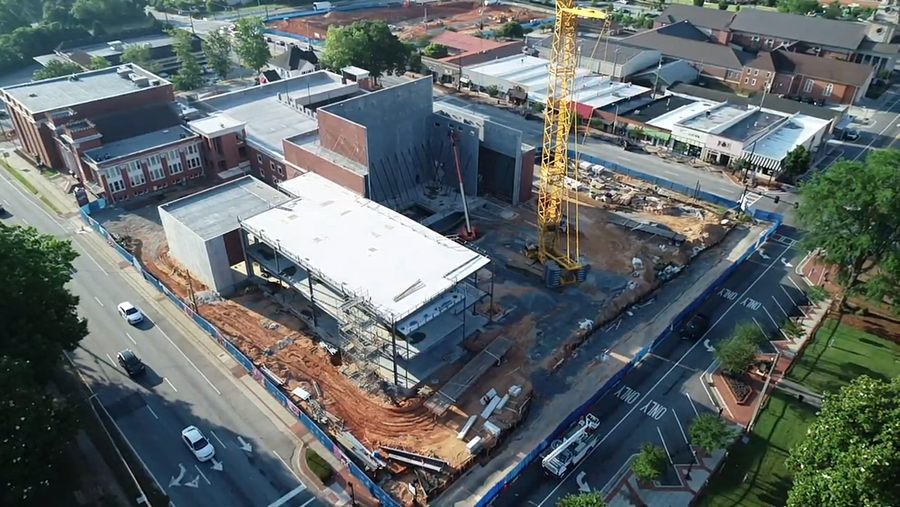
Lawrenceville Performing Arts Center
A unique partnership between the Aurora Theatre and the city of Lawrenceville, Ga., the Lawrenceville Performing Arts Center (LPAC) is a testament to the investment of municipal funds in regional arts and culture initiatives.
Seeing that in Georgia the arts and culture industry generates more economic impact than agriculture, sports, and education, the city invested in that local revenue stream and shouldered the fiscal responsibility of the construction. Of the $35 million budget for the LPAC project, Aurora Theatre and co-founders Anthony Rodriguez and Ann-Carol Pence only raised $5 million. The city of Lawrenceville footed the remaining $30 million through a special-purpose local-option sales tax, bonds, and other funding mechanisms.
“After completion, it is Anthony and my desire to challenge cities throughout our country to employ this model,” said Pence. “Cities all over the nation get the ‘soul’ benefit from a regional theatre. We provide the strength, programming, and the tourism that you need to revitalize your city.”
After the two-year construction project that broke ground in June 2019, the 56,000-square-foot center will have three theatres, with the expansion adding a 500-seat Grand Theatre with orchestral pit and fly loft, and a flexible cabaret space with an operational glass wall that opens onto a large courtyard. Designed by SSOE / Stevens & Wilkinson and built by Carroll Daniel Construction, the project also includes rehearsal space, dressing rooms, education space, and an art gallery.
Using funds from the CARES Act, Aurora was able to put an additional $2 million into health and safety upgrades, including touch-free fixtures and an HVAC system with a MERV 13 filter, a system recommended by the Center for Disease Control and Prevention (CDC) and the National Institute for Occupational Safety and Health (NIOSH) to capture fine particulates. Additionally, Aurora will invest in more sound equipment and wireless microphones, obviating the need for performers to share microphones. The funds also expanded the performance capacity of the exterior space, which will allow Aurora to host more outdoor events.
Neither the pandemic nor the construction project has dissuaded Georgia patrons from getting their arts fix. Aurora Theatre has been hosting small in-person events since December, but LPAC patrons are chomping at the bit to attend a full-capacity performance. “It’s really hard for some of our patrons to understand why we’re not back working at 100 percent capacity, because Georgia restaurants are trying to get back to normal,” Pence said. “I don’t think we’re going to have to convince people to return. The hard part is convincing people that we really are trying to keep everyone safe [with reduced capacity].”
The LPAC is aiming to be substantially completed by June and hopes to mount the first performance in the new facility in October.
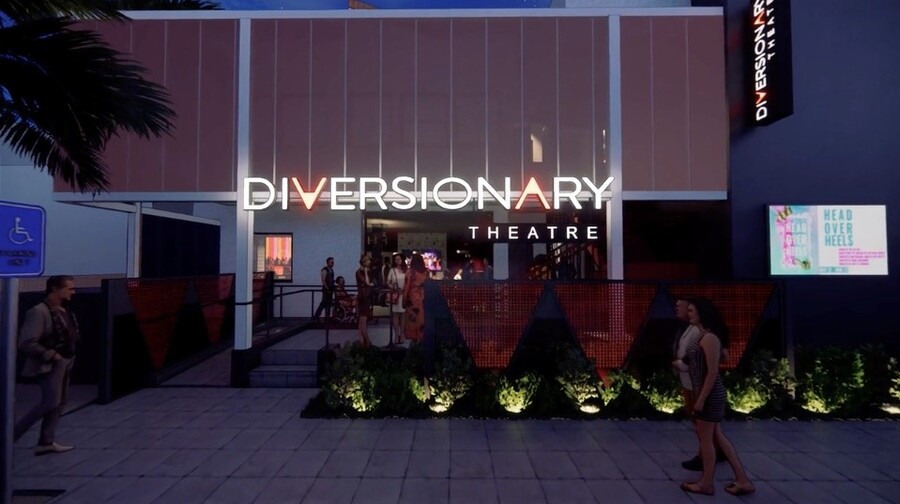
Diversionary Theatre
For Diversionary Theatre in San Diego, Calif., the building renovation isn’t as much about creating a regional arts investment as it is about ensuring a safe environment for patrons and performers. The $2.5 million comprehensive campaign is titled Securing Our Future.
“Diversionary was born during the AIDS crisis,” said managing director Jenny Case, referencing the theatre’s founding in 1986 to highlight social issues facing the LGBTQ community. “So being a safe, secure home, being a environment of community, and being safe together is part of our mission.”
The only theatre in San Diego that owns and operates its own building, Diversionary performed a feasibility study in 2019 to estimate the cost of upgrading their performance space, a former medical office, into a safe theatrical environment. When the pandemic surged last spring, Diversionary had only raised 35 percent of their funding goal. But a $500,000 matching donation from Robert L. Granat & Alfred J. Mazur—one that included funds to pay off the theatre’s mortgage and contribute to campaign labor, the change in revenue during construction, and operating expenses—set the pace for the campaign, allowing Diversionary to reach their goal six months early despite pandemic downturn.
Designed by the local firm Safdie Rabines Architects, the renovation includes an overhaul of the building’s entry, new marquee, expanded stage, and an education center—a resource shared with the Lambda Archives of San Diego—as well as new safety features, such as optimized air circulation with MERV13 filtration and bipolar ionizations, touch-free facilities, increased seating size, sanitizing stations, and easy-to-clean surfaces with anti-microbial materials.
Diversionary is also adding a new cabaret space, a nod to the community’s history. “The cabaret space is really meant to honor the gay bar, where our community has gathered, organized, and really launched the LGBTQ movement,” said executive artistic director Matt M. Morrow. “It will also pay homage to ‘the gay bar’ as a space that is threatened right now as the LGBTQ community is making inroads to the mainstream.”
Posed to complete construction this summer, Diversionary will reopen its doors as soon as state and local mandates allow, taking the next step in the future of the theatre.
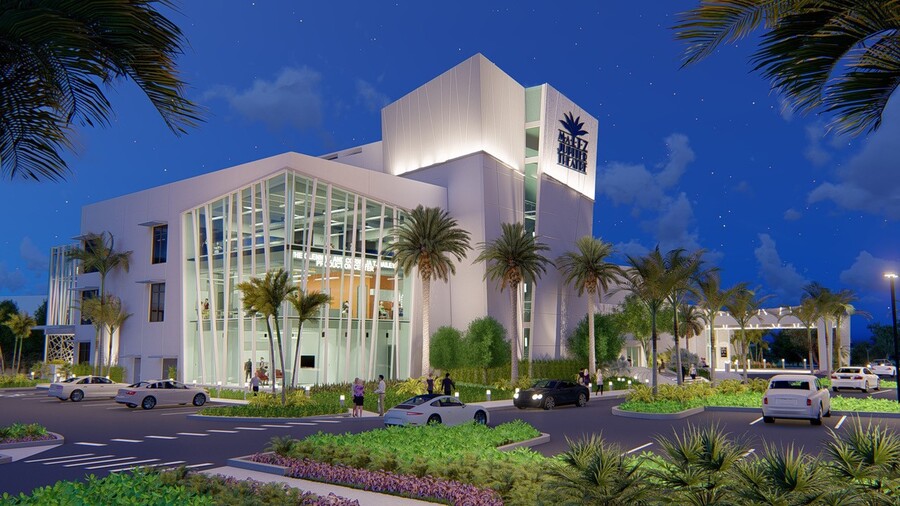
Maltz Jupiter Theatre
For some theatres, renovation projects have provided a source of hope throughout the pandemic and its fiscal challenges. Florida’s Maltz Jupiter Theatre had been preparing for five years for a $30 million expansion, slated to break ground in April 2021. But when performances were cancelled, the theatre chose to advance the project’s start date. The decision wasn’t taken lightly, considering that in 2020 Maltz Jupiter furloughed 80 percent of staff, cut 80 percent of its budget, and cancelled the conservatory program that trains 600 students each year.
The theatre braced for pushback, but, said producing artistic director and chief executive Andrew Kato, “My colleagues across the country applauded our use of this time. Directors, choreographers, and artisans who have been watching our progress are our biggest cheerleaders. They’ve really embraced the excitement that will come from basically doubling the square footage in our building and improving our facilities.”
The expansion will allow Maltz Jupiter to mount pre-Broadway productions, double educational capacity, and have more programmatic diversity, with a larger stage, three-story production facilities with floor-to-ceiling windows, café dining, conservatory, new lobby and entrance, and a 199-seat second theatre space, as well as standard disease-prevention safety and sanitation measures. Designed by Currie Sowards Aguila Architects with theatre consultation by TSG Design Solutions, the project was split into phases to accommodate budget and performance schedule. The first phase will update the building’s shell and main theatre before the 2021-22 season. The other spaces were “grey boxed,” or framed and air-conditioned, and will be finished out when funding allows.
To keep patrons and artists engaged, Maltz Jupiter releases a bi-monthly newsletter called “Real Brief” that details the construction updates and provides previews of the upcoming season, scheduled to open on Halloween 2021 with a production of Agatha Christie’s Murder on the Orient Express.
When the project drags or the financial situation is discouraging, the theatre keeps its eye on the prize: The $56 million in revenue the new theatre is projected to bring to the community. “Everything about the project was built on objectives, to strengthen our organization and create more opportunities for our community,” Kato said. “The process of adding to an existing building has its complications. But occasionally, I’ll allow myself to remember that something wonderful is going to happen at the end of this journey.”
As these theatres have capitalized on the mandated closures to renovate and rebuild, and as vaccination rates continue to rise, the quiet auditoriums don’t feel so quiet anymore. Hammers are banging away, fresh paint is drying, and lights are being tested in preparation for reopening and a return to live, in-person performances. Maybe—just maybe—the coronavirus pandemic shutdown will one day be seen as the longest pre-production period in history.
Kate Mazade (she/her) is a writer, designer, artist, and traveler exploring the connections between architecture and community. Her writing has been featured in Architectural Record, Madame Architect, The Architect’s Newspaper, The Syracuse Post-Standard, The Charleston Post and Courier, The NewsHouse, and the South Side Stand.

